Optimizing drilling dynamics with acquisition and analysis of high-resolution downhole data
Cultivating an understanding of complicated downhole drilling dynamics, which impact performance and profitability, enables operators to better plan future well campaigns and optimize operating parameters. To that end, Chevron Upstream Europe collaborated with National Oilwell Varco (NOV) to run a comprehensive analysis of high-resolution downhole run data, obtained from NOV’s BlackBox tools, on a multi-well extended-reach drilling (ERD) project. This allowed Chevron to determine performance limiters and develop a plan to mitigate or eliminate such problems on subsequent wells and future field expansions.
DRILLING DYSFUNCTION
Chevron planned to drill a group of challenging sidetrack ERD wells in the North Sea’s Captain field. The operator was commonly experiencing high torque and intermittent excessive vibration at the surface, which resulted in decreased drilling performance, damage to equipment, and in the worst case, total depth (TD) being called early.
Chevron decided to use downhole data analysis, provided by NOV’s dynamic drilling solutions engineers working with the eVolve suite of optimization products and technologies, to validate and enhance extensive modeling previously carried out by the operator. The service provider’s engineers validated the operator’s theory that high contact forces between the string and wellbore were generating significant amounts of whirl in the drill pipe. This was caused largely by doglegs close to surface and pipe compression through the build section. The following section examines four wells of interest in the project. The discussion includes observations on the collected downhole drilling dynamics data, and the detailed drilling procedure recommendations agreed upon for implementation in future wells.
CASE HISTORIES
Well 1. Downhole data acquisition in the first well aimed to validate a new drillstring design identified by Chevron for mitigation of the anomalous torque in the 8½-in. section. Well 1 was planned as a sidetrack from an existing subsea donor well, which originally experienced dramatic torque in the 8½-in. section, leading to TD being called early. Torque-reducing subs were trialed in the cased section of the original well but were found to provide little benefit in reducing vibration.
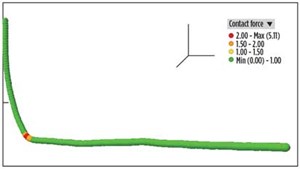
As Well 1 shared an almost identical trajectory with the donor well (Fig. 1), the first acquisition run offered a prime opportunity to validate and enhance the new drillstring design. This design omitted all the 5½-in. heavyweight drill pipe, traditionally run in the low-inclination portion of the well. The string was a tapered design with 5-in. drill pipe positioned below a 5½-in. drill pipe to surface. The goal was to trial an entire string of 5½-in. drill pipe in Captain field. The optimization strategy was to place BlackBox data recorders at two positions in the drillstring, allowing for an accurate post-run evaluation of drilling dynamics in both the bottomhole assembly (BHA) and drill pipe.
Chevron and NOV noted that drilling torque was significantly lower than in the offset well, and no surface vibration was visible. This was confirmed with the analysis of the high-frequency downhole data, which showed a low degree of lateral pipe movement, indicating an absence of whirl. Based on this data, engineers concluded that the new string design was a definitive improvement over the previous design.
Further analysis of the recorded downhole data highlighted a secondary drilling dysfunction in the form of stick-slip. This was linked primarily to an increase in mechanical friction from an accumulation of cuttings downhole. Vibration was noted to decrease after periods of circulation. The following measures were recommended for implementation on future wells to manage the risk of stick-slip:
- Stop drilling and circulate, if torsional vibration is noted to continually increase.
- Stage up the RPM after connections to avoid a surge in torque, which may trigger vibration.
- Increase RPM to full drilling rate before moving the string, to provide the BHA with enough angular momentum to resist stalls.
Well 2. The well was designed with a complex corkscrew trajectory, pushing the envelope of previous achievements in the North Sea, Fig. 2. Well 2 was planned as a sidetrack below the “tortuous” surface casing of a donor well. High dogleg spots were common in the low-inclination surface sections throughout the original wells drilled in the 1990s. Previous studies conducted by Chevron indicated these spots as a possible cause for pipe whirl, leading to high lateral contact forces and high torque. Due to a very high localized dogleg (7.4°/100 ft), Well 2 offered a prime opportunity to record drilling dynamics in the shallow section of the well, with the use of three BlackBox tools located at pertinent positions in the drillstring.
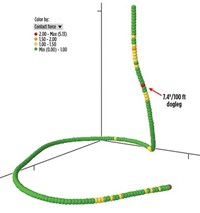
Also, due to equivalent circulating density (ECD) and torque/drag limitations, the use of a hybrid 5-in./5½-in. string was required. The secondary objective of the data acquisition subs was to understand the dynamic performance of this string configuration in a severe ERD environment.
In the 8½-in. section, consistent forward whirl was observed throughout the run during on-bottom drilling. This was confirmed with the aid of frequency analysis of the high-resolution BlackBox data. Forward whirl was noted to decrease or disappear entirely, when the string was in tension. Modeling showed a risk of buckling in the 5-in. drill pipe across the build section. It was believed that this lateral deflection in the pipe created a sufficient off-center mass to initiate forward whirl.
Backward whirl was present during the second half of the run. ROP was seen to decrease, despite an increase in surface torque, which is typical of backwards whirl. The source of the backwards whirl was identified as a high contact force point in the low-inclination section around a 7.4° dogleg. This observation provided strong support to Chevron’s theory around the correlation of shallow dogleg severity and reservoir drilling torque. The risk of backward whirl increased with depth, as the contact forces over the dogleg area also increased, and using high RPM increased this risk further.
This presented a potential dilemma between hole cleaning and vibration mitigation, where RPM is a key factor. ECD increased 5% over the run, and pickup weights deviated away from the trend toward TD, which highlighted an opportunity to further improve hole cleaning. TD was reached within a good margin from operational limits.
The use of BlackBox recorders and NOV’s data interpretation was key to validating the root cause for high surface torque, and provided valuable information to further optimize field ERD practices:
- High torque while drilling the reservoir section correlates with high dogleg spots at low inclination.
- Although the doglegs responsible for the excitation force cannot be removed from existing donor wells, there is an opportunity to improve tophole directional drilling design for future new-spud wells.
- Prioritize use of top-to-bottom 5½-in. drill pipe, to reduce the risk of buckling and attempt to increase annular velocity around the pipe.
- RPM reduction was observed to reduce the severity of vibration. A trade-off between RPM reduction and hole-cleaning efficiency should be evaluated carefully.
- Reducing RPM without stopping rotation completely may not be enough to break the whirl cycle.
Well 3 was an ERD well planned as a sidetrack below the surface casing of a donor well. The BlackBox strategy differed slightly from Wells 1 and 2, in that it included a 12¼-in. section, as well as an 8½-in. section. Although the drillstring passes through the same tophole section when drilling the 12¼- and 8½-in. boreholes, there is no historical record of high surface torque/pipe whirl when drilling the 12¼-in. section.
The primary objective of the BlackBox was to compare the dynamics between the two sections, with a goal of understanding what was preventing high torque in the 12¼-in. section. The secondary objectives were to improve understanding of the severe stick-slip commonly seen when drilling the 12¼-in. section, and to evaluate the dynamic behavior of the tapered string design in the 8½-in. section.
Results of 12¼-in. section. No evidence of pipe whirl was recorded in the 12¼-in. section. It was believed that the greater standoff between the pipe and the casing, along with the use of 5½-in. drill pipe top to bottom, was responsible for the absence of whirl.
Stick-slip was found to be the major drilling dysfunction. Full stick-slip first appeared during on-bottom drilling shortly after initiating the sidetrack, though as the run progressed, stick-slip was also present during off-bottom rotation. Torsional vibration decreased dramatically as the BHA transitioned out of the chalk group, revealing that wellbore friction, as opposed to bit torque, was the major driver for stick-slip. When drilling the cement, high-amplitude axial and torque fluctuations were noted, as well, which had the potential to damage the bit by overloading discrete cutters.
Although the bit was pulled in good condition, the MWD tool reported significant amounts of high lateral vibration. Parameters were varied widely throughout the section to manage this risk, which negatively impacted ROP. The ideal solution for future wells involved a combined approach, where stick-slip was managed or eliminated to maximize ROP:
- Stick-slip management—limiting input RPM would generally reduce the maximum slip RPM; however, increasing WOB with a lower RPM could increase stick-slip severity further. Parameter fingerprinting could be used to identify the optimal RPM/WOB combination for chalk drilling.
- Stick-slip elimination—a surface torque feedback system was to be evaluated, to eliminate stick-slip.
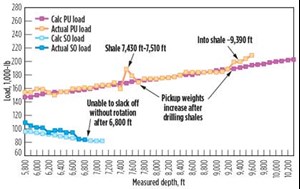
Results of 8½-in. section. As torque wasn’t a limiting factor for this well, a conventional 5-in. × 5½-in. tapered string was run to favor ECD over torque. A significant amount of pipe whirl, which appeared initially in the form of forward whirl, was recorded during the run. It is believed that lateral deflection in the 5-in. drill pipe, due to compression, was responsible for the dysfunction. This was demonstrated by surface torque increasing significantly when compressing the string with only a marginal increase in BHA torque.
Backward whirl was also observed toward the end of the run, as the 5½-in. drill pipe passed through the end of the build section inside the casing. This is unusual in Captain field, as backward whirl has previously only been associated with doglegs close to surface. The combination of side forces through the build section and mechanical friction from accumulated shale cuttings was found to be the cause. Figure 3 depicts how pickup weights increased after drilling shale intervals.
After completing the BlackBox data analysis, the following was observed and concluded:
- The fact that there was no pipe whirl in the 12¼-in. section, while such whirl was dominant in the 8½-in. section, provided two important conclusions:
- Stick-slip and pipe whirl appeared to be mutually exclusive.
- The 5½-in. string used in the 12¼-in. section was significantly less prone to whirl, as the greater stand-off between the pipe and casing in the section also reduced the risk of exciting backwards whirl.
- The stiffer top-to-bottom 5½-in. string was confirmed to provide better drilling dynamics, due to its ability to better resist deflection and forward whirl.
- If available, a parameter set that promoted stick-slip over whirl (for the same ROP) was preferred.
- The amount of shale cuttings should be minimized, due to the difficulty of evacuating them from the wellbore. To do this, Chevron should closely observe the transition to shale, which can be seen by an increase in ECD and standpipe pressure. Additionally, the operator should consider improving hole-cleaning practices to clear the cuttings.
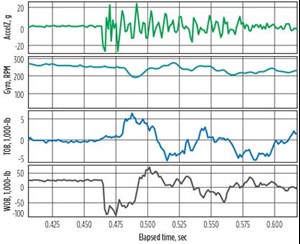
Results of 12¼-in. section. Stick-slip was common during the run, as with other wells in Captain field. There was a low-risk vibration with a weak coupling to lateral shocks. The lateral shocks associated with stick-slip were noted to decrease when inclination exceeded 33 degrees. This was attributed to the positive affect of gravity holding the BHA to the low side of the hole. Excessive axial shocks were recorded downhole when reaming at the end of each stand. This was traced to the hydraulic jar firing accidentally, Fig. 4. As the jar was put under compression during drilling, it caused it to cock and then fire when the string was picked up. A spike in downhole annular pressure was recorded when circulating at the end of the run, and pumping out of hole without rotation was flagged as a concern. Downhole data analysis revealed:
- The risk of accidental jar firing could be mitigated by altering the string pickup procedure or by running a jar with a mechanical latch. The jar placement cannot be improved, due to the high neutral point in ERD wells.
- Lubricating out of hole without rotation could generate an accumulation of cuttings. If wellbore stability is a concern, RPM should be limited to the minimum required for hole cleaning.
Results of 8½-in. section. Two 8½-in. sections were drilled in Well 4. These were the first 8½-in. runs to be drilled with a full string of 5½-in. drill pipe, as hydraulic modeling suggested ECD would remain within safe limits with the larger-diameter pipe. Pipe whirl was not visible at surface but was recorded in the downhole data on both runs. Pipe whirl was also visible in a deviation in surface torque away from the modeled trend, which occurred in both runs after the same footage was drilled. This would suggest whirl in Well 4 was linked to either string length or the volume of cuttings. There was no clear backwards whirl frequency recorded in the downhole data, as in the offset wells.
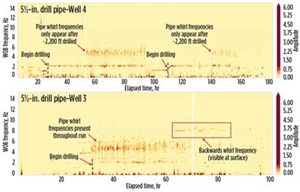
Figure 5 shows a comparison between the tapered string and full 5½-in. design. Using 5½-in. drill pipe delayed the onset of pipe whirl, appearing after approximately 2,200 ft drilled. This string design also showed no visible evidence of backward whirl frequency, as present in the tapered string design. This confirms that the full 5½-in. string is more resistant to whirl than the tapered design.
Following BlackBox data analysis, engineers agreed on the following conclusions for Well 4, based on all data gathered during the collaboration:
- Severe off-bottom axial shocks were a result of accidental jar firing. Chevron will risk-assess the use of a jar in future wells.
- Pumping out-of-hole without rotation should be avoided, and hole-cleaning procedures should be revised.
- Torque trends could be monitored to identify potential pipe whirl in Captain field.
- Although the risk of exciting whirl is largely a function of well profile, the full 5½-in. string design is more resistant to whirl than the 5-in. × 5½-in. tapered design.
VALUE ADDED
Difficult downhole conditions will remain a threat to cost-effective wellbore construction, particularly in brownfield environments where reach continues to increase. A structured learning journey, which should include field validation of predictive modeling using downhole data recorders, will be required to successfully overcome these challenges.
In this application, downhole data acquisition was key for Chevron and NOV to prove, and address, the source of high torque, which was limiting the operator’s ability to increase well reach farther. The ability to place BlackBox recorders along the string, combined with high-resolution data, was pivotal in determining the source of drilling dysfunctions.
Identification and verification of the root cause of the abnormal surface torque, combined with further ERD practice enhancements, fulfilled Chevron’s initial business case. NOV’s high-resolution data, in line with the operator’s collaboration, provided valuable insight into downhole drilling dysfunctions, which in turn improved overall standard drilling practices and parameters. ![]()
- Advancing offshore decarbonization through electrification of FPSOs (March 2024)
- Subsea technology- Corrosion monitoring: From failure to success (February 2024)
- Driving MPD adoption with performance-enhancing technologies (January 2024)
- Digital transformation: A breakthrough year for digitalization in the offshore sector (January 2024)
- Offshore technology: Platform design: Is the next generation of offshore platforms changing offshore energy? (December 2023)
- 2024: A policy crossroads for American offshore energy (December 2023)


